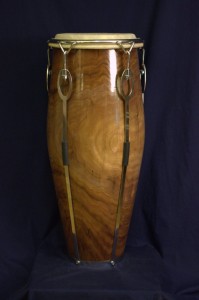The best way to make our drums sound better, be it conga or djembe drum, is to play better. That means practicing and learning. I am constantly working on my tones, slap and bass. I watch other people play, take lessons and watch Youtube videos as well. For me, it is a never ending learning process of trying to perfect my playing technique. And no matter how long we play, we can always learn something new, I don’t care who you are. Even the greats can learn something from someone else.

Besides improving our personal playing technique, the next best way to improve the sound of your drum is to change the skin. Often, skins are either mismatched for our playing style, for where we play the drums (band, studio, dance class or with other drummers for example) or simply to thick or too thin.
If you have a commercial drum, like most of us do such as an LP or one made in Thailand in the last 10 years or so chances you have a water Buffalo skin on your drum. They often are bumpy or lumpy.I like to sand these skins down to make a smoother playing surface and it really helps for playing fast hand techniques.
Most skins are put on the drum randomly. All of my Toca drums came with medium thick skins for example. They are not bad skins they really project well and have great rebound. But the tonal quality, the fullness and depth of tone is not there.
So what kind of skin would make your drum sound better? I asked Ryan Manito Wendel, owner and builder at Manito Percussion his thoughts on some subjects relating to skins and skin selection.
M.P.: Ryan, when someone calls and asks you “what kind of skin should I put on my drum”? What do you tell them?

Manito: Well, first and foremost it’s a personal choice. There is no one “right answer.” Every type of skin has its own characteristic sound and feel. I usually start out by asking what it is they like or dislike about the skins they have now and what type of music they play most.
It’s not only the animal type that matters, but how the skin is processed and how thick the skin both are important factors.
M.P.: Is there one skin that does it all, like an all sesaon tire that will make someones drum sound better?
Manito: Well, sort of- but again it’s really all personal choice. Most people tend to like sound of steer skin as well as rebound action they give. The white skins have their internal fibers sort of fluffed and opened up, then they are saturated with an oil component. This effectively dampens overtone ring while maintaining volume and giving warm tones. The natural brown steer is more dense and brighter sounding, also a bit harder.
M.P.: How about Mule skin?
Manito: Mule is a tricky skin. When it is thick like you use on congas, it is very hard on the hands and tends to take more energy to get the sounds out at high volume. But the slaps are exquisitely sharp. I’ve heard thick mule vary from bright to muffled, which is normally a factor of matching the thickness to the drum itself. A mule skin that’s too thick, on say a requinto, will often sound dead and flat. The sound does open up over time as the skin stretches out.
M.P.: Is there a break in period for new skins?
Manito: All skins have a break in period in which the sound really opens up as the skin gets accustomed to being pulled on and the fibers begin setting themselves in place. The tone and volume will increase over the break in period and the slaps become sharper.

White steer tends to break in fastest, within 2 weeks or so while natural steer can take longer and mule can take months to reach its sound potential.
M.P.: I have heard people are starting to use Mule Slin for djembes?
Manito: Thin mule ends up being a bit more bouncy and has more rebound than thin cow. It is denser, but it has a lower oil content so it vibrates very well in the high frequency range where djembes like to be tuned. I use anywhere from .5mm (5 sheets of paper) to 1mm (10 sheets) for djembes. You can use sheets of paper as a measurement form instead of a measuring device. Mule skins last much longer than goat and tend to produce much less ring.
M.P.: Do you suggest someone put on their own skin when purchasing a new skin?
Manito: I’d recommend having help the first time mounting a rope tuned head like a djembe, but congas and bongos are much more novice friendly.First, don’t oversoak the skin. It normally takes 1-3 hours to soak a skin unless it is very dense and thick. Use warm water to soak it and it will penetrate faster. Second, have a set of pointed locking pliers and some spring clamps handy. They give you an “extra hand” and make it much easier.
M.P.: I like the concept of being able to call an expert such as yourself and get a specific recommendation by you for a specific skin for my drum and my personal needs. IS that possible?
Manito: I’m always glad to answer questions about skins and help people pick out the best skin for their particular situation. Please feel free to contact me via email with any questions.
CLICK ON THE BROWN LINK BELOW TO BE TAKEN DIRECTLY TO MANITO PERCUSSION
http://www.manitopercussion.
Manito Percussion is located 10 minutes north of Athens, GA.

Ryan ‘Manito’ Wendel
info@manitopercussion.com
706-614-4563

